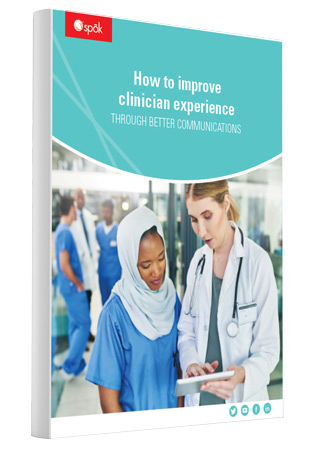Blog
How to improve clinician experience through better communications
 How can you improve communications to enhance the provider experience and pursue the quadruple aim?
How can you improve communications to enhance the provider experience and pursue the quadruple aim?
In an effort to address the widening levels of burnout and dissatisfaction among healthcare professionals, many health systems are expanding the traditional pursuit of the triple aim—better outcomes, lower costs, and improved patient experience—by adding improved clinician experience. Thus, the long-recognized triple aim has expanded to a quadruple one.
This eBook will examine three of the most serious issues facing healthcare providers today—alarm fatigue, workplace violence, and physician burnout—to explore how improved healthcare communications can help make positive impacts on these extremely important and complex subjects.
Alarm fatigue
According to 2011 research on medical device alarms, there were no more than six alarms for each critically-ill patient in 1983. By 2011, there were at least 40 types of clinical alarms. Alarm fatigue is also ranked among the ECRI Institute’s top health technology hazards for 2020. Alarm fatigue has made the list every year since its creation 13 years ago and held the No. 1 spot from 2012-2015.
Ensuring alerts go to the right person can reduce the amount of unnecessary notifications staff may receive, reduce time spent searching for the correct contact, and decrease overhead announcements. Not only does this reduce the amount of noise in the care environment, it allows for faster response to alerts.
Workplace violence in healthcare
The rate of violence for those in healthcare is as much as twelve times higher than for those in other professions and the American Nurses Association says this rate has “reached epidemic proportions.” Workplace violence is a reality for providers. In fact, violence is so ingrained in their work it’s become part of the healthcare culture as a “necessary part of the job.”
Communication technology can help achieve OSHA’s recommendations for developing a workplace violence protection program in healthcare. Though changing workplace violence in healthcare won’t happen through technology alone, communication is key in the critical moments when seconds and minutes make a significant difference.
Physician burnout
Each year the complexity of being a caregiver increases as the weight of administrative tasks increase and the healthcare environment continues to shift rapidly. These, and other, frustrations are widespread and expanding, leading to growing levels of burnout. In a 2019 survey, 92% of clinicians agree burnout is “a public health crisis.” Just as burnout is complex, so are its causes and the steps to combat it.
Streamlining communication can help improve technology, decrease phone tag, and reduce friction and frustration to help alleviate physician burnout.
Download the eBook today to learn more about how improved communications can be part of the solution to better care for our providers in the pursuit of the quadruple aim.






